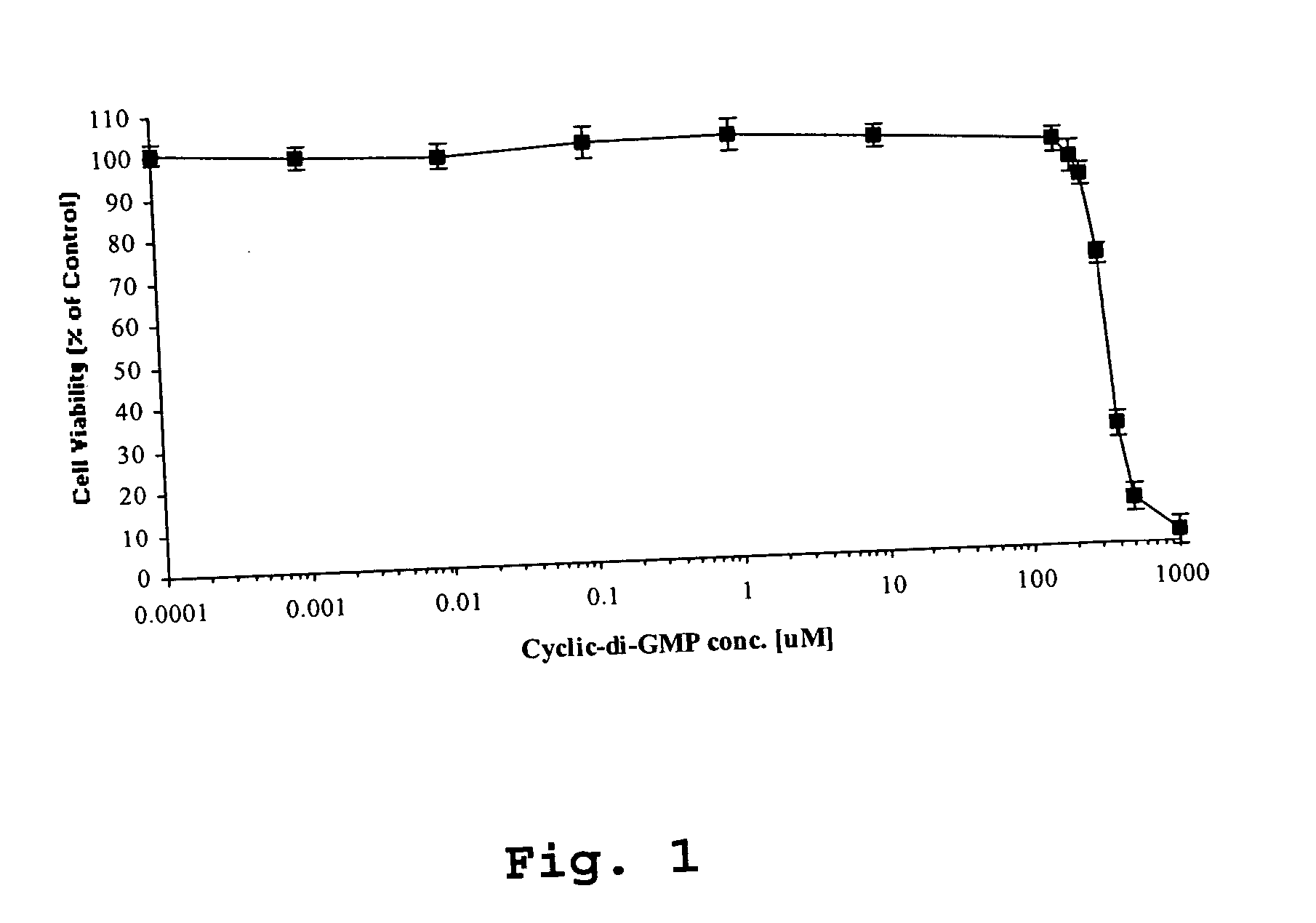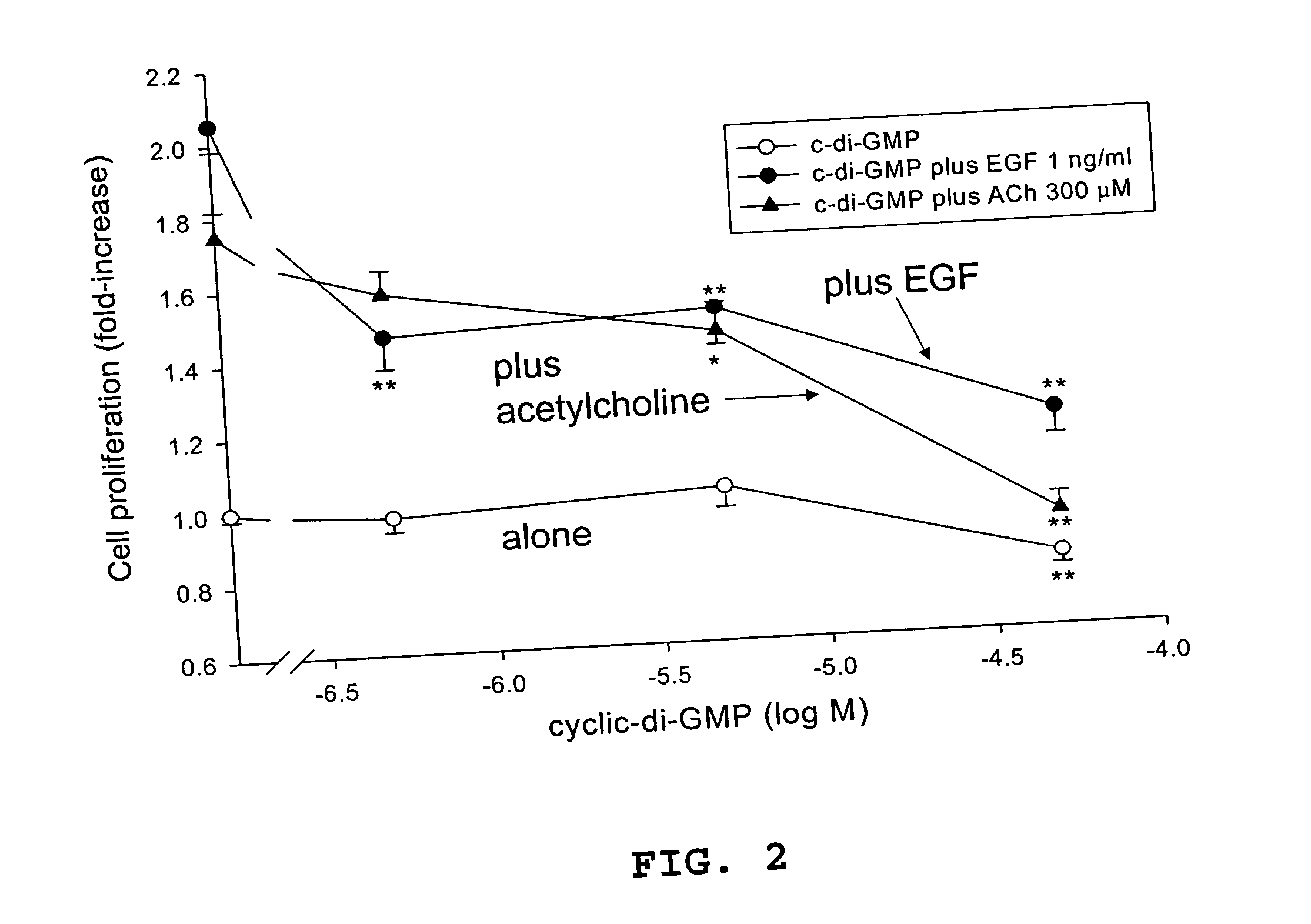Method for inhibiting cancer cell proliferation or increasing cancer cell apoptosis
a cancer cell and apoptosis technology, applied in the field of cyclic dinucleotides, can solve the problems of inability to understand the cellular pathways underlying these events, the stimulation of cancer cell proliferation, and the only marginal effect of advanced disease treatment (stages iii and iv), and achieve the effect of increasing cancer cell apoptosis and inhibiting cancer cell proliferation
- Summary
- Abstract
- Description
- Claims
- Application Information
AI Technical Summary
Benefits of technology
Problems solved by technology
Method used
Image
Examples
example 1
[0049] In the experiments reported in this example, c-di-GMP (≦50 μM) is shown to have striking properties regarding inhibition of cancer cell proliferation in vitro. c-di-GMP inhibits both basal and growth factor (acetylcholine and epidermal growth factor)-induced cell proliferation of human colon cancer (H508) cells. Toxicity studies revealed that exposure of normal rat kidney cells and human neuroblastoma cells to c-di-GMP at biologically relevant doses showed no cytotoxicity.
MATERIALS AND METHODS
[0050] Chemicals and reagents. c-di-GMP was synthesized in pure form using a recently described novel method that produces a pure, high yield preparation of c-di-GMP diammonium salt (Hayakawa et al., 2003; and Hyodo et al., 2004). Structurally-related nucleotides (guanosine 3′,5′-cyclic monophosphate (cGMP) and guanosine 5′-monophosphate (5′-GMP); both from Sigma)) were also examined. Dulbecco's Modified Eagle Medium, MEM non-essential amino acids, penicillin, streptomycin and G418 wer...
example 2
Determining the Molecular Mechanism Whereby Cyclic Dinucleotides Inhibit Human Colon Cancer Cell Proliferation
[0066] The results in Example 1 demonstrate that cyclic-di-GMP inhibits basal and growth factor-induced colon cancer cell proliferation. In the present example, it is proposed to explore further in H508 and other colon cancer cell lines the dose-dependence, reproducibility and mechanism of these actions. Before examining the actions of cyclic-di-GMP on cell signaling and nuclear changes related to cell cycle progression and apoptosis, it is proposed to determine directly the ability or inability of cyclic-di-GMP to bind to the plasma membrane or to enter colon cancer cells and act at intracellular sites by using fluorescent and radioactively labeled cyclic-di-GMP. It is also proposed to examine whether labeled cyclic dinucleotide enters colon cancer cells and to use affinity chromatography to determine whether the molecule interacts with specific molecules in the plasma mem...
example 3
[0074] Frequently, in mammalian cells, anti-proliferative agents cause G1 phase cell cycle arrest. Cessation of proliferation is the final outcome of anti-proliferative agents, but the mechanism of cell cycle arrest varies depending on the cell type and the molecular mechanism of the agent's actions. The results in Example 1 indicate that cyclic-di-GMP inhibits basal, as well as growth factor-induced colon cancer cell proliferation. In particular, experiments with H508 human colon cancer cells indicate that the cyclic dinucleotide inhibits acetylcholine- and EGF-induced H508 cell proliferation. It is possible, but not likely, that the cyclic dinucleotide acts as muscarinic or EGF receptor inhibitor or that the agent blocks post-receptor signaling. For example, in H508 colon cancer cells, increasing concentrations of cyclic-di-GMP do not inhibit either acetylcholine- or EGF-induced phosphorylation of p44 / 42 MAPK (Erk 1 / 2). Hence, the present inventors believe that it is more likely t...
PUM
| Property | Measurement | Unit |
|---|---|---|
| Fraction | aaaaa | aaaaa |
| Fraction | aaaaa | aaaaa |
| Fraction | aaaaa | aaaaa |
Abstract
Description
Claims
Application Information
 Login to View More
Login to View More - R&D
- Intellectual Property
- Life Sciences
- Materials
- Tech Scout
- Unparalleled Data Quality
- Higher Quality Content
- 60% Fewer Hallucinations
Browse by: Latest US Patents, China's latest patents, Technical Efficacy Thesaurus, Application Domain, Technology Topic, Popular Technical Reports.
© 2025 PatSnap. All rights reserved.Legal|Privacy policy|Modern Slavery Act Transparency Statement|Sitemap|About US| Contact US: help@patsnap.com



